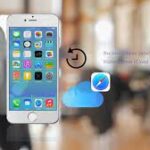How To Recover iPhone Data After Restore Without Backup
 If you’ve had an iPhone for a long time, chances are your device contains information that is extremely valuable to you. However, if the data on your device ever becomes inaccessible or corrupted, recovering it can be very difficult and expensive. Luckily there are some simple steps that anyone with access to an old backup of their iOS Device can take to recover lost data without losing any new files they may have acquired since the last backup was made.
If you’ve had an iPhone for a long time, chances are your device contains information that is extremely valuable to you. However, if the data on your device ever becomes inaccessible or corrupted, recovering it can be very difficult and expensive. Luckily there are some simple steps that anyone with access to an old backup of their iOS Device can take to recover lost data without losing any new files they may have acquired since the last backup was made.
Restoring your iPhone without backing up its data will make you lose everything. This is why it is important to always back up your phone before restoring it. But what if the backup was corrupted, or you haven’t backed up in a while? Fortunately, there are several ways to recover lost data even after restoring an iPhone without backup. However, not all of them are effective, and they are only worth trying if your backup was recent or if you know that you don’t have any other photos or files that are not yet backed up anywhere else. Here are some ways to recover lost data after restoring an iPhone without backup.
What To Do Before You Restore Your iPhone
If you have important data on your iPhone and you don’t have a backup, do not perform a restore. The only way to recover lost data from an iPhone is to use a backup or iphone data recovery that was made before the device was restored or to use data recovery software.
Do it first if you have any other way of getting your photos and files off the phone. This includes using iCloud and uploading them to an online storage service like Dropbox or Google Photos. If you don’t have any other backups of your data, backup your device now if it is not already backed up. You should also make sure that the backup is encrypted so that anyone who has access cannot see what’s in it. If it is not encrypted, go ahead and encrypt it now before restoring your device.
Try iCloud Backup
One of the most convenient ways to recover lost data after restoring an iPhone without backup is using iCloud backup. It is a good idea to enable and keep iCloud backup enabled in Settings before you restore your phone. This way, you can still recover your lost data even after restoring your iPhone without backup.
To recover from an iCloud Backup, ensure that you have a stable internet connection and then go to Settings > Your Apple ID > iCloud > iCloud backup. Here, select Restore from iCloud backup and ensure that the latest backup is selected on the screen. If it isn’t, click the date to change it before clicking “Restore.”
Restore From iTunes Backup
If you have backed up your phone with iTunes before, the easiest way to recover lost data is to restore from an iTunes backup. All you need to do is connect your iPhone to a computer and choose “Restore from Backup” in the Summary tab. This will allow you to restore from an iTunes backup, which will work as long as you have backed up recently.
Recover Data From iCloud, Dropbox, Google Drive, etc.
If you have backed up your data to iCloud, Dropbox, Google Drive, etc., you can recover your data by restoring the backup. This is the best option if the backup was recent or you know that you don’t have any other photos or files that are not yet backed up anywhere else.
Recover Data From Your Computer
If you have synced your iPhone with your computer, there is a chance that the syncing process will have saved anything new or changed on your phone. One way to recover data from your computer is by using iCloud to back up photos.
- If you’re not already logged into iCloud, do so now by opening System Preferences and navigate to iCloud.
- Click “Restore Photos” to sync all of the current images on your iPhone with iCloud.
- If you don’t have an internet connection, open Finder and navigate to “MobileSync/Backup.” Double-click the most recent date folder to find the last backup for your phone.
- There should be a subfolder called “Library” where all the Photos are located.
- Drag these folders into another location in Finder, like Desktop or Documents, then delete them from the MobileSync/Backup folder before attempting step 2 again.